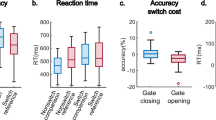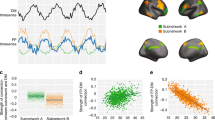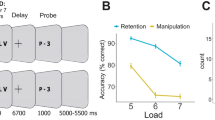Abstract
Working memory is responsible for the short-term storage and online manipulation of information necessary for higher cognitive functions, such as language, planning and problem-solving1,2. Traditionally, working memory has been divided into two types of processes: executive control (governing the encoding manipulation and retrieval of information in working memory) and active maintenance (keeping information available 'online'). It has also been proposed that these two types of processes may be subserved by distinct cortical structures, with the prefrontal cortex housing the executive control processes, and more posterior regions housing the content-specific buffers (for example verbal versus visuospatial) responsible for active maintenance3,4. However, studies in non-human primates suggest that dorsolateral regions of the prefrontal cortex may also be involved in active maintenance5–8. We have used functional magnetic resonance imaging to examine brain activation in human subjects during performance of a working memory task. We used the temporal resolution of this technique to examine the dynamics of regional activation, and to show that prefrontal cortex along with parietal cortex appears to play a role in active maintenance.
This is a preview of subscription content, access via your institution
Access options
Subscribe to this journal
Receive 51 print issues and online access
$199.00 per year
only $3.90 per issue
Buy this article
- Purchase on Springer Link
- Instant access to full article PDF
Prices may be subject to local taxes which are calculated during checkout
Similar content being viewed by others
References
Baddeley, A. D. Working Memory (Oxford Univ. Press, New York, 1986).
Shallice, T. From Neuropsychology to Mental Structure (Cambridge Univ. Press, Cambridge, 1988).
Gathercole, S. E. Neuropsychology and working memory: a review. Neuropsychology 8, 494–505 (1994).
Paulesu, E., Frith, C. D. & Frackowiak, R. S. J. The neural correlates of the verbal component of working memory. Nature 362, 342–345 (1993).
Fuster, J. M. & Alexander, G. E. Neuron activity related to short-term memory. Science 173, 652–654 (1971).
Goldman-Rakic, P. S. in Handbook of Physiology: The Nervous System (eds Plum, E & Mountcastle, V.) 373–417 (American Physiological Society, Bethesda, Maryland, 1987).
Barone, P. & Joseph, J. P. Prefrontal cortex and spatial sequencing in macaque monkey. Exp. Brain Res. 78, 447–464 (1989).
Miller, E. K., Erickson, C. A. & Desimone, R. Neural mechanisms of visual working memory in prefrontal cortex of the macaque. J. Neurosci. 16, 5154–5167 (1996).
Cohen, J. D. et al. Activation of prefrontal cortex in a nonspatial working memory task with functional MRI. Hum. Brain Map. 1, 293–304 (1994).
Smith, E. E., Jonides, J. & Koeppe, R. A. Dissociating verbal and spatial working memory using PET. Cereb. Cortex 6, 11–20 (1996).
Braver, T. S. et al. A parametric study of prefrontal cortex involvement in human working memory. Neuroimage 6, 49–62 (1997).
Savoy, R. L. et al. in Society of Magnetic Resonance, 3rd Meeting 450 (International Society of Magnetic Resonance in Medicine, Nice, 1995).
Vazquez, A. L. & Noll, D. C. Non-linear temporal aspects of the BOLD response in fMRI. Proc. Int. Soc. Magn. Res. Med. 4th Meet. 1765 (1996).
Kwong, K. K. et al. Dynamic magnetic resonance of human brain activity during primary sensory stimulation. Proc. Nat. Acad. Sci. USA 89, 5675–5679 (1992).
Tulving, E. et al. Neuroanatomical correlates of retrieval in episodic memory: auditory sentence recognition. Proc. Nat. Acad. Sci. USA 91, 2012–2015 (1994).
Fiez, J. A. et al. A positron emission tomography study of the short-term maintenance of verbal information. J. Neurosci. 16, 808–822 (1996).
Courtney, S. M., Ungerleider, L. G. & Keil, K. & Haxby, J. V. Transient and sustained activity in a distributed neural system for human working memory. Nature (this issue).
Jonides, J. et al. Verbal working memory load affects regional brain activity as measured by PET. J. Cogn. Neuroscience (in the press).
Cohen, J. D., Braver, T. S. & O'Reilly, R. A computational approach to prefrontal cortex, cognitive control, and schizophrenia: recent developments and current challenges. Phil. Trans. R. Soc. Lond. B 351, 1515–1527 (1996).
D'Esposito, M. et al. The neural basis of the central executive system of working memory. Nature 378, 279–281 (1995).
Petrides, M. E. Functional specialization within the dorsolateral frontal cortex for serial order memory. Proc. R. Soc. Land. B. 246, 293–298 (1991).
Barch, D. M. et al. Dissociating working memory from task difficulty in human prefrontal cortex. Neuropsychologia (in the press).
Awh, E. et al. Dissociation of storage and rehearsal in verbal working memory: evidence from PET. Psychol. Sci. 7, 25–31 (1996).
Waters, G., Rochon, E. & Caplan, D. The role of high-level speech planning in rehearsal: evidence from patients with apraxia of speech. J. Mem. Lang. 31, 54–73 (1992).
Cohen, J. D., MacWhinney, B., Flatt, M. R. & Provost, J. PsyScope: a new graphic interactive environment for designing psychology experiments. Behav. Res. Meth. Instru. Comput. 25, 257–271 (1993).
Ogawa, S. et al. Intrinsic signal changes accompanying sensory stimulation: functional brain mapping using MRI. Proc. Nat. Acad. Sci. USA 89, 5951–5955 (1992).
Noll, D. C., Cohen, J. D., Meyer, C. H. & Schneider, W. Spiral K-space MR imaging of cortical activation. J. Magn. Reson. Imag. 5, 49–56 (1995).
Woods, R. P., Cherry, S. R. & Mazziotta, J. C. Rapid automated algorithm for aligning and reslicing PET images. J. Comp. Assist. Tomogr. 16, 620–633 (1992).
Forman, S. D. et al. Improved assessment of significant activation in functional magnetic resonance imaging (fMRI): use of a cluster-size threshold. Mag. Reson. Med. 33, 636–647 (1995).
Cox, R. W. AFNI: software for analysis and visualization of functional magnetic resonance neuroimages. Comput. Biomed. Res. 29, 162–173 (1996).
Author information
Authors and Affiliations
Rights and permissions
About this article
Cite this article
Cohen, J., Perlstein, W., Braver, T. et al. Temporal dynamics of brain activation during a working memory task. Nature 386, 604–608 (1997). https://doi.org/10.1038/386604a0
Received:
Accepted:
Issue Date:
DOI: https://doi.org/10.1038/386604a0
This article is cited by
-
Cognitive effects on experienced duration and speed of time, prospectively, retrospectively, in and out of lockdown
Scientific Reports (2024)
-
Working memory during spontaneous migraine attacks: an fMRI study
Neurological Sciences (2024)
-
Efficacy and safety of Transcranial Direct Current Stimulation (tDCS) on cognitive function in chronic schizophrenia with Tardive Dyskinesia (TD): a randomized, double-blind, sham-controlled, clinical trial
BMC Psychiatry (2023)
-
Mnemonic-trained brain tuning to a regular odd-even pattern subserves digit memory in children
npj Science of Learning (2023)
-
How low working memory demands and reduced anticipatory attentional gating contribute to impaired inhibition during acute alcohol intoxication
Scientific Reports (2022)
Comments
By submitting a comment you agree to abide by our Terms and Community Guidelines. If you find something abusive or that does not comply with our terms or guidelines please flag it as inappropriate.



